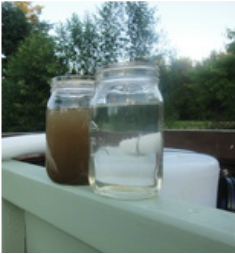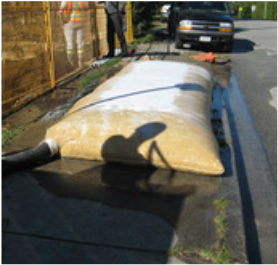TIGERFLOC

To lower the water turbidity for erosion and sediment control site run-off and for industrial wastewater treatment, Tigerfloc flocculant is now available. Tigerfloc flocculant is granular and very easy to use, works faster and better than Chitosan flocculant, and is more cost effective. Whether you require removal of fine sediment, hydrocarbons, or heavy metals from your waste water, Tigerfloc works quickly to remove all contaminants in the water column.
Tigerfloc can be applied directly and mixed into the water for contaminant removal, or can be used passively by pumping water over a Tigerfloc Belt to reduce the water turbidity.
Advantages to using Tigerfloc:
Tigerfloc can be applied directly and mixed into the water for contaminant removal, or can be used passively by pumping water over a Tigerfloc Belt to reduce the water turbidity.
Advantages to using Tigerfloc:
- Reduced Quantity of Chemicals
- Increased Settling Rates
- Increased Hydraulic Capacity
- Increased Flocculent Size
- Improved Flocculent Shear and Mixing
- Heavy Metals Removal and Recovery
- Sludge Leachability Tests
- Enhanced BOD/TSS Removal
- Reduced Impact on TDS/EC
- Meets US EPA TCLP (toxicity testing)
- Works Over Broader pH Ranges (4 to 12)
- Unaffected by low temperatures
- Reduced Costs
Tigerfloc belts & kodiak dirt bags

A new water treatment alternative that is being used very successfully on many construction sites now is the combination of a Tigerfloc Belt placed inside of a mixing tube, which then empties out into a micro-pored dewatering bag. The Tigerfloc Belt and Dewatering Bag Unit works well almost immediately filtering out almost all of the sediment from the discharge water.
The Tigerfloc Belt and Dewatering Bag Unit has proven useful in all soil types: sand, silts, and even clays. Many case studies of water passing over the Tigerfloc Belt and then through the Dewatering Bag - results: incoming water measured at >1000 NTUs dropped to under 25 NTUs.
Another option on sites that already have a sediment control pond (still exceeding the allowable discharge limits), is to re-circulate the pond’s water through the Tigerfloc Belt and Dewatering Bag Unit and then empty the clean water into the sediment control pond prior to it discharging down the drain pipe. By re-circulating the water over the Tigerfloc Belt, it will help speed-up the process of sedimentation.
The Tigerfloc Belt and Dewatering Bag Unit is extremely effective, is mobile, has a small footprint on site (approximately 20’ x 20’), and is much cheaper than other alternatives which may compete with these results. It is something to think about the next time you have a site where there might not be enough space for a sediment pond, and you don’t require something as heavy-duty (or as expensive) as a mechanical ‘pump-and-treat’ system.
Click here for .pdf for insertion into ESC drawings by Professional Engineers or CPESC.
The Tigerfloc Belt and Dewatering Bag Unit has proven useful in all soil types: sand, silts, and even clays. Many case studies of water passing over the Tigerfloc Belt and then through the Dewatering Bag - results: incoming water measured at >1000 NTUs dropped to under 25 NTUs.
Another option on sites that already have a sediment control pond (still exceeding the allowable discharge limits), is to re-circulate the pond’s water through the Tigerfloc Belt and Dewatering Bag Unit and then empty the clean water into the sediment control pond prior to it discharging down the drain pipe. By re-circulating the water over the Tigerfloc Belt, it will help speed-up the process of sedimentation.
The Tigerfloc Belt and Dewatering Bag Unit is extremely effective, is mobile, has a small footprint on site (approximately 20’ x 20’), and is much cheaper than other alternatives which may compete with these results. It is something to think about the next time you have a site where there might not be enough space for a sediment pond, and you don’t require something as heavy-duty (or as expensive) as a mechanical ‘pump-and-treat’ system.
Click here for .pdf for insertion into ESC drawings by Professional Engineers or CPESC.
